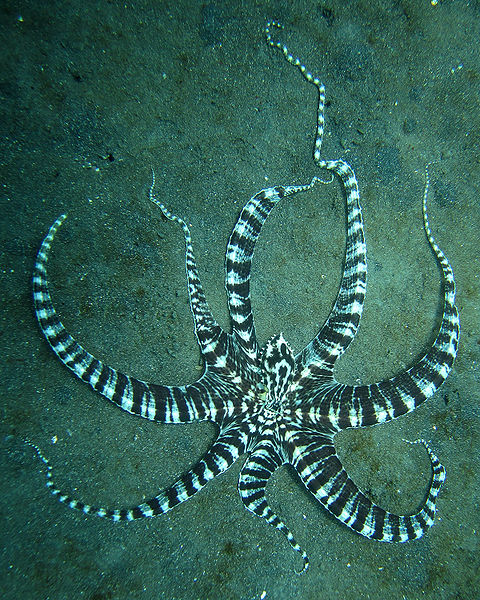Does the mimic octopus have a split personality or does it just like dressing up?
 Find out more:
Find out more:
The evolution of conspicuous facultative mimicry in octopuses: an example of secondary adaptation?
Helen- But first, I've got one of my personal favourites. These guys aren't especially Christmassy, but they have an eye-popping repertoire of party tricks up their tentacles, and I think they'd definitely be fun to have around. So, my choice for Christmas critter number three is the mimic Octopus.
They were discovered in 1998 in Indonesia where they live in sandy silty areas around river mouths. And they've been caught on camera putting on an extraordinary range of impersonations of other animals.
They will stick all but two of their arms down a hole, then make the other two stripy and wave them around like a sea snake. They can lay their arms out flat and swim across the seabed like a flat fish. They wave their arms over their heads to look like a lionfish. And it's thought they can also do impressions of anemones, sting rays, mantis shrimp, and even jellyfish.
Sarah- It's pretty spectacular stuff, but do we have any idea why they do it?
Helen——好吧,吓跑和迷惑捕食者to be the most likely explanation because lots of the creatures they mimic are poisonous - so they can pretend to be dangerous by co-opting the fearsome reputation of others. And that's something that lots of other animals do, like non-stinging bees that have evolved yellow and black stripes to look like wasps.
But the thing about the mimic octopus it's the only animal that we know of that mimics a wide range of other animals and can switch between them minute by minute. And this means they can tailor their impersonations depending on what is threatening them at any particular time.
A recent study has looked into how the mimic octopus evolved just one of its clever tricks - the flatfish impersonation. Researchers found that this is a combination of first evolving the ability to change colour quickly - this confuses predators, almost like shouting at them with colour, which is something that many octopus species do. Then the mimic octopus ancestors evolved long arms and figured out at the same time how to wrap them around themselves, squash themselves flat and swim above the seabed like a flat fish. Combine that with the colourful display, and they put on an uncanny impression of a venomous flatfish.
So, Paul the Octopus may have become a worldwide celebrity for his weird football predicting skills, but there are some other even more surprising talents to be found in the rest of the octopus world.
- PreviousAnyone for turkey?
- NextChristmas tree worms
 Find out more:
Find out more:








Comments
Add a comment